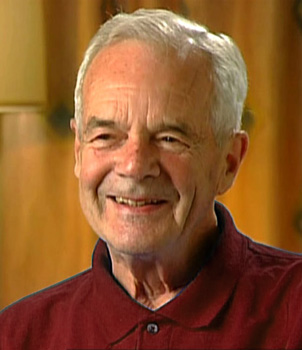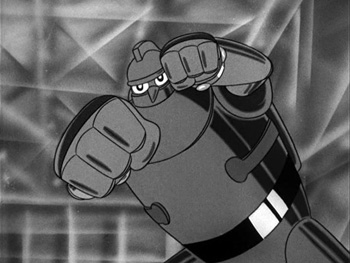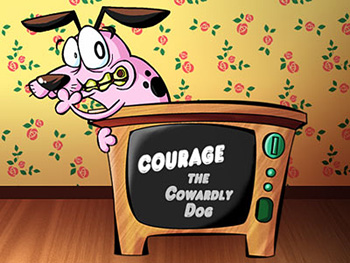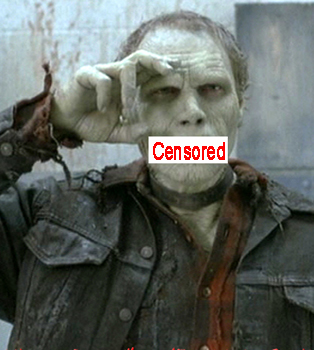The Man of a Thousand Dub Tracks Author: Bob Johnson Special Thanks to Keith Aiken and Aaron Cooper
Peter Fernandez is probably one of the more famous of the many behind the scenes heroes that work hard so we can enjoy movies and television shows from other countries. Most people who have heard of him think about SPEED RACER when Peter`s name is mentioned. And why not? Peter was the producer, director and writer of the series, as well as the voices of Speed Racer and Racer X. However, there is so much more to the man than just one series or two characters. Since the 1940s, Peter has been a child model, a Broadway and movie actor, and a key figure responsible for most of the dubbing for movies and shows we`ve all grown up watching from Japan, China, Italy, Mexico and other countries. In addition to SPEED RACER, his long list of voice credits includes GODZILLA VS THE SEA MONSTER, ASTROBOY, ULTRAMAN, THE SPACE GIANTS, SON OF GODZILLA, GIGANTOR, STAR BLAZERS, the Sergio Leone/Clint Eastwood spaghetti westerns... and even a "clean version" of George Romero`s DAY OF THE DEAD! In this interview we tried to touch on all aspects of his life and work to give readers a better understanding of the remarkable career he has had. Even so, I feel we only managed to scratch the surface.
SciFi Japan: How did you get started in show business? What was your background?
Peter Fernandez: From when I was seven to when I was eleven I was a boy model, you know… for still ads. I was on EVERYTHING, billboards, everything! I always worked with a little blonde girl whose mother wanted to be an actress. She persuaded my mother into setting me up to see about a Broadway show.
 Peter Fernandez in the mid-1960s. Around this time he was creating the English versions of SPEED RACER, ULTRAMAN, and Toho monster movies. Photo courtesy of Steve Ryfle.
Peter Fernandez in the mid-1960s. Around this time he was creating the English versions of SPEED RACER, ULTRAMAN, and Toho monster movies. Photo courtesy of Steve Ryfle.So, I got the part, showed up for the first day’s rehearsal and at the end of it, my mother said, “We’re not coming back!” I said, “Why not?” She says, “The theater’s dirty”. Well it was an empty theater you know, with a single light bulb. That’s the way you rehearsed in those days. So, she called a friend, the mother of a boy named Billy Redfield, who became William Redfield in a lot of plays and movies and he did show up. OK fine, so a month later I got called up to see Ethel Barrymore at the Hotel Elise in New York. I went up into the hotel with my mother and we got back into the elevator, it was my eleventh birthday, and my mother said, “Well, they want you”. I fell on the floor, over-dramatizing it. I was with that play, WHITEOAKS it was called, for two years with Ethel Barrymore [starting in 1938]. Played Broadway, toured all over the United States and Canada. After that I did a whole string of Broadway shows, including one called WATCH ON THE RHINE [in 1941], during which I ended up having dinner with President Roosevelt at his table. But that’s another story… At the same time casting directors and directors of radio would see these shows and they’d call me for radio. So, I got very busy on radio at the same time. It remained that way until I got drafted at the age of eighteen into the army. I always wanted to be a writer and one morning at 6:00am, I’m hiding from the inspectors of the barracks, I was a mail clerk at that time, and I started writing. I wrote a poem. A poem about beer, the beer they served in the army. I had a hangover and wrote a poem called, “Oh, That PX Beer!” and it got published in Our Army magazine. I thought wait a minute, I can get published too! When I got out of the army, there was a lot more competition in radio and I had seen these guys sitting around, waiting for the phone to ring. I couldn’t spend my life waiting for the phone to ring. So, I started writing and wrote a whole bunch of pulp magazine stories, mostly westerns. Some took place in the Alaskan wilderness. I knew nothing about those places, but the stories got published.
 Early publicity shot of actress Brigitte Bardot for the French hit AND GOD CREATED WOMAN. Peter got his start as a dubbing actor for the English language version of this film. ©1957 Cocinor/Iena Films/UCIL-Cocinor
Early publicity shot of actress Brigitte Bardot for the French hit AND GOD CREATED WOMAN. Peter got his start as a dubbing actor for the English language version of this film. ©1957 Cocinor/Iena Films/UCIL-CocinorThen I got the lead in a film in Hollywood. I was touring in the summer with Arthur Treacher in a Pinero comedy, very British and so forth, and I was called in to New York to audition for a film called CITY ACROSS THE RIVER [1949] with a Brooklyn accent. Well, I got that part, a lead in a Hollywood film [editor’s note: Peter played a member of a Brooklyn gang who accidentally killed a teacher. The cast also featured Tony Curtis and Richard Jaeckel]. I did that, but I didn’t like Hollywood, so I came back to New York the day we finished shooting. I didn’t feel comfortable there. Besides that, I had a girlfriend in New York (laughs). This was in the early days of television and I started writing as radio dwindled and television became stronger. I was writing some of the last radio show scripts, and acting on them. Shows like SUSPENSE [1949], and then everything moved to California. My first wife and I bought a farm in Pennsylvania and I was desperate for work and I started getting called for dubbing jobs. Starting with a Bridgette Bardot film. My wife in the meantime, was doing Bardot’s voice in these films. So, that is how I got into dubbing. [editor’s note: The Bridgette Bardot film was AND GOD CREATED WOMAN (Et Dieu Créa la Femme, 1957), a controversial international hit due to Bardot’s sexuality. Peter’s wife had worked on Broadway and did live TV before getting the job as Bardot’s screen voice.]
SFJ: So, a lot of your career path was decided on necessity? Given the choice, would you have preferred to remain a straight-forward actor?
PF: A lot of it was just luck I guess. I look back on those days and I loved radio, I still do. It is my favorite medium. Unfortunately there is no radio around, except for doing commercials, which I do some.
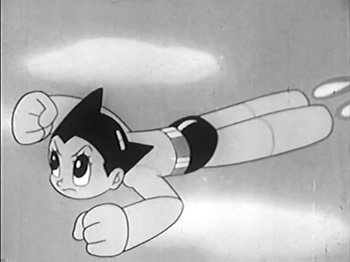 There he goes, ASTROBOY! Peter created the English language scripts for Osamu Tezuka`s first anime series. ©1963 Mushi Productions
There he goes, ASTROBOY! Peter created the English language scripts for Osamu Tezuka`s first anime series. ©1963 Mushi ProductionsAnyway, as dubbing came along I got involved in that and I got called in as an actor, but realized that the writers of the scripts were getting paid good money. The directors got paid even more. Writers got five percent of the budget, directors got ten percent. The directors didn’t have to do much, the writers do all the work! So, I went on a one-man strike at Titra and said I wouldn’t write anymore unless I got to direct them. They had to concede to that, which they did and that’s how I got into writing and directing for dubbing. At that time, Fred Ladd got in touch with me. He said he had this series of cartoons and “I would love you to write for me, write the dubbing scripts, but I only pay $100.00 per script.” I was still desperate for money, so I started writing the scripts for a show called ASTROBOY. Then Fred had another one, called GIGANTOR and asked me to do the same thing and I said yes. He cast me in the show as well. So I did that. Two editors I knew said “we’re being offered a series here by Trans-Lux”, which was a distribution company and asked if I could take a look at it and see if I wanted to do it. I saw one or two episodes and started writing and it was turned over to me. The only instructions from the distributor was “Americanize it!” so, I could name the characters. The translation scripts from Japan were very poor at the time, so I had to invent most of the dialog. Being the director, I cast myself in the two best parts, Speed Racer and Racer X and hired a few friends to do the other voices. That’s how SPEED RACER got started.
SFJ: The original scripts you got from Japan, were they actual scripts or just plot overviews?
PF: They tried to copy the dialog from Japan, translate it, but at that time these translations were very crude, which was fine with me, as long as I knew what was going on. So I could write sometimes outrageous dialog and name all the characters outrageously and it was work, but it was fun.
SFJ: You had quite a flair for coming up with descriptive names for the characters. Is that something you just came up with as you looked at each character?
PF: Yes, I just came up with the names. It was fun!
SFJ: Going back to Titra for a minute, were you at Titra from the beginning or were you hired later on?
PF: I was hired by their directors to do voices in some of the films and I was in a lot of the films being dubbed at that time. Great films were coming from all over the world that needed to be dubbed, because in New York, the East side of New York so to speak, would not want to see a dubbed film. They wanted to see them subtitled and listen to the original dialog spoken by the actors. But the rest of the country wanted English and that’s how that whole business originally got started. The amusing thing is that the people wanting to hear the original dialog seldom heard it, because in Europe they voiced it later and Italy always shot silently, nothing to go by except what they had dubbed into Italian. So they didn’t write any dialog at all until they finished shooting a film.
SFJ: And cartoons would be even more extreme, because they are all dubbed from the start anyway.
PF: I don’t think they dubbed them in Japan. I think they put down the tracks and animated to that. Which is the way it is done today.
SFJ: I know you’ve done it both ways, writing scripts after the fact and before the animation…
PF: Yes, I did that with a series called MARINE BOY, which I was recording at the same time I was doing SPEED RACER. In fact, I used the same cast on MARINE BOY as I did on SPEED RACER, we just switched voices. Corrine Orr, who was Trixie on SPEED, was Marine Boy himself.
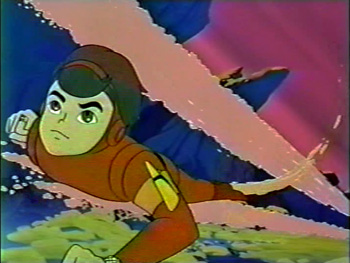 MARINE BOY, voiced by Corinne Orr, swims into action! The main voice cast of SPEED RACER also created the English version of this show. © 1966 Japan Tele Cartoons/ Seven Arts Television
MARINE BOY, voiced by Corinne Orr, swims into action! The main voice cast of SPEED RACER also created the English version of this show. © 1966 Japan Tele Cartoons/ Seven Arts TelevisionSFJ: That is a series I’d like to know more about, because it is sort of a lost series now. How did that come about? It was more of a co-production, wasn’t it?
PF: Yes, as I understand, it laid buried in the Warner Brothers vault for years and I kept telling people, try to resurrect it, it’s a great series. I learned that somebody had let the copyrights lapse. I guess anyone could release it now if they had good source material.
SFJ: How was that series created? Who came up with the concept?
PF: All I know is I was contacted by a young man who was in charge of a film company called Seven Arts and he wanted it done with a real boy doing Marine Boy’s voice, but limited me to four in the cast and I said I can’t do that. A real boy can’t alter his voice to become villains and everything else. He insisted, so I did a five-minute demo with Corrine doing the boy and well, after that I had no trouble and that young man was named Stan Jaffe, who was the son of Saul Jaffe at Columbia Pictures and Stan, I think, went on to become the head of Paramount Pictures.
SFJ: Maybe we can touch on SPACE GIANTS a little bit. How did that come about?
PF: Well, the same way. A distributor got in touch with the editors, who got in touch with me. Pablo Zavala and Sheldon Riss were the two guys’ names [from Zavala-Riss Productions]. SPACE GIANTS… I did not like doing it. There was so much dialog! They never stopped talking. On top of that, the action that was animated was repeated every few episodes, as if it were a new scene.
SFJ: Well, I guess if you are watching it as a weekly show, you don’t notice it as much as when you are watching it day after day.
PF: Exactly. But that took forever to record each episode because of all the dialog.
SFJ: I guess you didn’t get paid per word…
PF: Oh no! And doing animated series in those days did not pay much at all. In fact with SPEED RACER, it ended up that I got $62.50 per episode for acting. That was it, no residuals.
SFJ: What are the differences between dubbing live action vs. animation?
PF: It didn’t matter to me. Dubbing was dubbing and I tried to do the best I could with the live-action and the same with the animated series. There are certain guidelines that help and are interchangeable between any languages. First of all you wanted to sound natural and you want the lines to start and end on time. But then there’s all that interior stuff. Labials for instance are the real key and there are only three letters in the entire alphabet where we close our lips and they are interchangeable from language to language. M, B and P. So I’d try to come up with combinations that had those labials in them. After that, in live-action you go for F’s and V’s and the’s TH’s.
SFJ: I would assume dubbing live action would be a lot more difficult because the mouth-movements are much more intricate. A lot of the time with animation the mouths open and close and that’s really it.
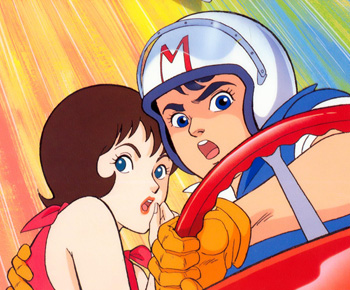 Promo art of Trixie and Speed! Peter was a voice actor and also wrote the English scripts and the famous theme song lyrics. ©1966 Tatsunoko Productions and Speed Racer Enterprises
Promo art of Trixie and Speed! Peter was a voice actor and also wrote the English scripts and the famous theme song lyrics. ©1966 Tatsunoko Productions and Speed Racer EnterprisesPF: Well, not always though in the animation. If you watch, even on SPEED RACER, sometimes I wrote speeches that you really had to rattle off fast because those lips were flapping like crazy! Trying to make it look like English…
SFJ: I know Japanese as a language, and probably Chinese too, is spoken much faster than English.
PF: Well, Japanese… or live-action Japanese, I always found very easy to write scripts for. Chinese was very difficult. The labials in Chinese all seem to come in a rush at the end of a sentence. Where as in Japanese they are spaced. Spanish is relatively easy as opposed to Portuguese. The romance languages are easiest… French, Spanish, Italian. In German you get a lot of words, but the words go on longer!
SFJ: At what point did you split off from Titra and start doing projects on your own?
PF: Hmmmmm… that’s a good question. Let’s see… shortly after SPEED RACER. Jack Curtis and Paula Rubenstein, who were married, were very unhappy working for Titra. I can’t remember why. The three of us decided we would start up a company on our own. Without Titra getting the films. So, we formed a company and I could see right away that wasn’t going to work. So, I broke away from them and went back to Titra, getting from Titra a guarantee of a certain amount of money per year, but I probably made more. Because I felt I somewhat betrayed Jack and Paulette, I gave them as much work as possible. Jack was on SPEED RACER and MARINE BOY. He was Inspector Detector.
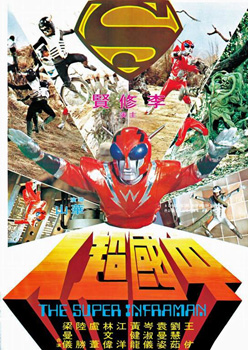 INFRAMAN, the man beyond bionics! Peter was voice director for the American release of the Hong Kong cult classic. ©1975 Shaw Brothers Studio
INFRAMAN, the man beyond bionics! Peter was voice director for the American release of the Hong Kong cult classic. ©1975 Shaw Brothers StudioSFJ: One of our staff told me to ask you about INFRAMAN, which you haven’t spoken too much about. That is probably the wildest film a lot of people have ever seen. It seemed like it might have been a fun project to work on.
PF: Yes, it was like a live-action cartoon! The distributor, Joe Brenner, a very, very nice man, I said to him the action in this towards the end is just endless and I persuaded him to cut about ten minutes out of it. Because it just went on until you almost didn’t care what happened or you didn’t know what happened. I had no idea though that it would become sort of a cult classic! It also ran long. The ideal running time then was about 90-minutes for a film. I had one crazy job for someone, I don’t remember whom, where they had a whole package of films running about 75 to 80 minutes each and they needed 90. So they turned them over to me to lengthen them. So, I did every trick I could think of like reversing a scene later on in the film, in other words, you see him in the film and he’s on the left side and later on he’s on the right. It is the same scene, only reversed. I wrote entirely different dialog for it when it was reversed so it is a totally different scene.
SFJ: So, back then 90-minutes was sort of the goal, or the key-time?
PF: Oh yes.
SFJ: Now it is more like two and a half or three hours!
PF: I know, I’ve been watching a few on my computer that I get down at the local video store. Because I never go to the movies.
SFJ: Using ULTRAMAN as an example, maybe you could walk us through the steps it took to dub and complete an episode?
PF: Well, ULTRAMAN was really a live-action cartoon I think. I wrote for it the way I did for any feature. I had a moviola, sometimes a projector, and I’d go back and forth over each line carefully and carefully, building the line to look like English. When you got to the dubbing studio, it was called a “loop”. Well that meant that when writing anything for dubbing, one took a grease pencil and marked the film where it was to be cut for just those few lines. The shorter the loop, the better and easier for the actor.
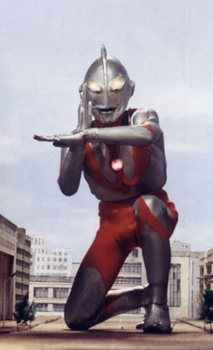 From a distant planet land comes our hero ULTRAMAN. Peter supervised the Americanization of this world famous show. ©1966 Tsuburaya Productions Co., Ltd.
From a distant planet land comes our hero ULTRAMAN. Peter supervised the Americanization of this world famous show. ©1966 Tsuburaya Productions Co., Ltd.When you went to the studio, that film was all cut up. A loop of the film and the rest leader. When it is projected on the screen, the actor memorizes the line so he or she can look at the screen and dub it. Well, how do you know where to start? That’s very difficult. So, in the studio there is a series of signals. Once you start right on the signal, you at least are starting correctly. The rest is up to you watching that screen. So in the studio you hear “Beep… beep… beep…” then you talk, as if there is a forth beep. Those beeps are drilled into me. They are two-thirds of a second apart. Later on, the film is reassembled and mixed with the original music and sound effects.
SFJ: So that must be a lot of work just editing that dialog back together, especially with multiple takes?
PF: Well, no. I would never give them a choice. I would always say, “that is the good take”. What are you going to do? Rely on the editors to pick the good take when you spent so much time directing it?
SFJ: How did you record the soundtracks? Was that on tape?
PF: Yes, it was done on tape, then back onto the film. Now of course it is all done on computer. There is no tape, though the engineer will still say, “we’re rolling” when you’re not really rolling, but we are doing the same thing, just electronically.
SFJ: Just a hard drive… “we’re spinning!”
PF: Yeah, right! (laughs). But I prefer now, doing the pre-recording. It’s tough on an actor for an hour, but it is very concentrated and I did COURAGE THE COWARDLY DOG that way. I directed the voices on that and I’m a voice myself for a lot of the villainous characters.
I would have each actor come in and it would take them about an hour to do a whole episode. But, I’d torture him for an hour, trying to get as many takes with a variety, so that the animators could say, “oh, this one works best, this is our choice”.
SFJ: Are you still dubbing foreign films or are you just working on your own projects now?
PF: I haven’t been called to dub a film in several years. They are all done in Vancouver, Hong Kong, Florida and Dallas. But what I am seeing is very poor quality, because no one has been taught how to write a proper sync script.
SFJ: I had heard that the films that are dubbed in Hong Kong, the companies just use English-speaking tourists that happen to be there and pay them for a day to read lines and walk away.
PF: Yeah, well I did go down for Titra and did a couple German Westerns. They were importing them and dubbing them in Mexico City. I went down with my lip-sync scripts and we held auditions endlessly to find a cast. They were desperate to come up with the actors for all this. At one point they let in a young blind man. I was asking myself how the heck could he dub? He said, “All you have to do is tap me”. Well, he did not get the part. The guy who got the part was not an actor. He was a heavy-set guy. He had the right voice and everything. But, the only way we could get a performance out of him, which he asked me to do, was to hit him! Shove my body against him. Anything like that. I’d be exhausted at the end of the day, but we got the performance!
SFJ: So, that was his cue to start?
PF: Yeah and to energize him.
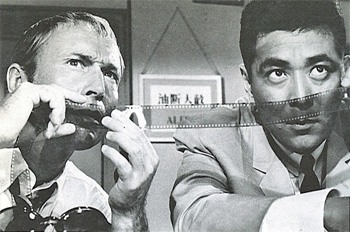 Nick Adams and Tatsuya Mihashi in THE KILLING BOTTLE. Peter wrote and directed the now-lost English dub of this Toho spy movie. ©1967 Toho Co., Ltd..
Nick Adams and Tatsuya Mihashi in THE KILLING BOTTLE. Peter wrote and directed the now-lost English dub of this Toho spy movie. ©1967 Toho Co., Ltd..SFJ: Someone showed me a clip about a Toho film called THE KILLING BOTTLE, which was made in Japan with Nick Adams as the lead. There was an ad that mentioned that Titra had actually dubbed it, but no one has ever really seen it. Do you remember that film at all?
PF: I vaguely remember it. I know I wrote and directed the English version. I don’t remember a lot about it, but I do remember the title. There was another film I did with Frankie Avalon. For years I was sworn to secrecy, but now who cares? I was Frankie’s voice. They didn’t want anyone to know that that was not his speaking voice. It was him singing, but they didn’t like his speaking voice, so I did Frankie Avalon. [editor’s note: This is believed to be the 1960 animated feature ALAKAZAM THE GREAT.]
SFJ: You mentioned a couple German Westerns, but you did the dubbing on some of the Spaghetti Westerns from Italy, didn’t you?
PF: I worked on the first two Clint Eastwood films. A FISTFUL OF DOLLARS and FOR A FEW DOLLARS MORE. They kept his voice, but I had to dub all the others.
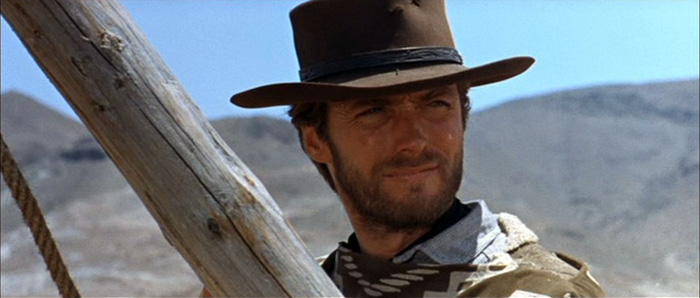 Clint Eastwood as The Man With No Name from A FISTFUL OF DOLLARS. While Clint provided his own voice for the American version, many of the supporting characters were dubbed in English by Peter Fernandez.©1967 United Artists/MGM
Clint Eastwood as The Man With No Name from A FISTFUL OF DOLLARS. While Clint provided his own voice for the American version, many of the supporting characters were dubbed in English by Peter Fernandez.©1967 United Artists/MGMSFJ: How would you isolate and keep his voice, while separating out and dubbing the others?
PF: I don’t recall, but I’m sure they had that all by itself. [editor’s note: There was never a voice track on location shooting during Sergio Leone’s films. These films featured such cosmopolitan casts and extras, that on location they would be speaking Italian, English, Spanish, Hungarian, etc. and were encouraged to just say their lines in whatever language they were comfortable with. The dubs were always overlayed in later, regardless of language or sound effects. In interviews, Clint Eastwood says the sets were quite noisy. There was no `quiet on the set` to capture the voicetracks during filming, as everyone knew it would all be dubbed in later in whatever language the distributors needed. That`s also why Leone could pipe in Morricone`s soundtrack on ONCE UPON A TIME IN THE WEST while filming to capture the mood he wanted the actors to be in for particular scenes on that movie.]
SFJ: One thing that jumped out at me when I was doing research for this interview, was George Romero’s DAY OF THE DEAD back in 1985. You did a “cleaner dialog version” of the film?
PF: Yes! They couldn’t play it down south. There were a lot of F words, curse words and everything else. So, to open up the market, basically for the south, it had to be cleaned up so, I had to redo whenever I came across a line. There were like 12 pages of dialog if I recall, of line changes.
SFJ: Would you just substitute other exclamations for the curse words?
PF: Yes. We’d use our labial system, which I mentioned earlier. No one knew where the original actors were. Somewhere in the depths of Pittsburgh I think. So someone would come as close to it as they can listening to it. If one line goes by that’s slightly different I don’t think anyone would notice.
SFJ: I wonder if that version is floating around anywhere?
PF: I don’t know whatever happened to it. I know that’s become a cult flick too.
SFJ: That pretty much brings us up to the present day. I know you have a pretty big cameo in the new SPEED RACER movie.
PF: Yeah, I didn’t know if I’d end up on the cutting room floor until I saw the film in New York at the premier. I was rather surprised! They flew me over to a studio outside of Berlin to do it. I really only worked one day. I did meet the Wachowskis, very nice guys. They said they were anxious to meet me. They said when they were kids they used to run home from school to catch SPEED RACER.
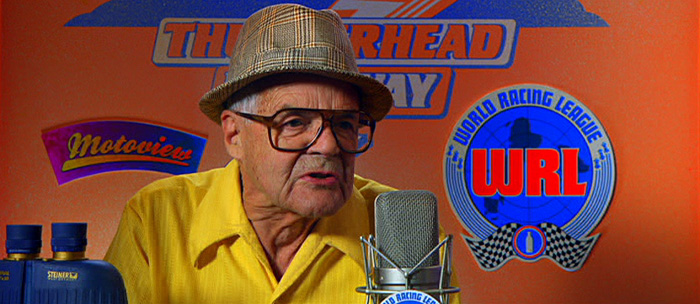 Peter Fernandez plays a racing announcer in the new SPEED RACER movie. ©2008 Warner Bros. Entertainment
Peter Fernandez plays a racing announcer in the new SPEED RACER movie. ©2008 Warner Bros. EntertainmentSFJ: Do you have any thoughts on the film? Do you think it caught the spirit of SPEED RACER?
PF: Yes, I think it did. I thought the casting was terrific. I thought the acting was terrific. The only thing I didn’t like were the races. I just didn’t feel any danger for Speed. They looked like a jumble of toy cars and sound effects. I feel the missed us caring about him during those races by not showing us inside at the driver’s seat while these things came at him.
SFJ: I know in some scenes they had drivers enveloped in a bubble and ejected before the crashes, whereas in the original series people were crashing and dying all over
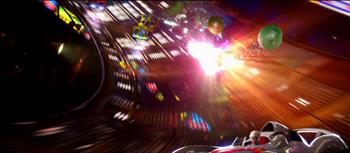 Unlike the original anime, drivers escape harm encased in bubbles in the new SPEED RACER movie. ©2008 Warner Bros. Entertainment
Unlike the original anime, drivers escape harm encased in bubbles in the new SPEED RACER movie. ©2008 Warner Bros. EntertainmentPF: I know. I tried to cut down on that violence in the original series with the dialog. For instance there would be a horrendous crash just over the hill. Arms would be flying through the air, legs, whatever. Then I would put in lines like, “He’s in serious condition in the hospital, but doctors say he will pull through!” (laughs). That at least softened it a bit I hope.
SFJ: It was kind of amazing to me that the original series has endured all these years and the new movie came out, didn’t spark much and off it went. Any idea why that might have been?
PF: I feel there are two great values to the original SPEED RACER. The first is cars. We all played with cars. Girls did too and that was one big draw to the series and the cars still look ultra-modern today. The other was the family. It was, I think, the first time in an animated series that a family was involved more than just a superhero or things like that. They were a family and we cared about the whole family and they cared about Speed. I think that added a great value to the series.
SFJ: The movie had both those elements. I’m just surprised it did so bad. I know a lot of the ads and trailers sort of had people confused about what they would be seeing in the theater. A lot of people thought they’d get sick from all the images and fast cuts and camera movements.
PF: I know a lot of people were saying, “we’re waiting for the DVD”.
SFJ: Were you contacted at all about the DVD? About doing any extras at all?
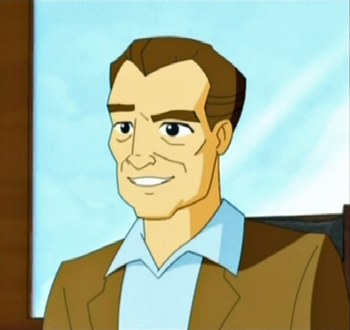 A grown Spritle voiced by Peter Fernandez in SPEED RACER: THE NEXT GENERATION. ©2008 Lions Gate and Speed Racer Enterprises
A grown Spritle voiced by Peter Fernandez in SPEED RACER: THE NEXT GENERATION. ©2008 Lions Gate and Speed Racer EnterprisesPF: No I wasn’t contacted about the DVD or the feature. Though I did a lot of publicity for it because at the time, on Nicktoons a new Speed Racer series started, called SPEED RACER: THE NEXT GENERATION. It takes place 35 or 40 years after the original series. Speed so far has not appeared in any of the 26 episodes there were recorded. However, they had me do a character from the original, which Corrine and I get a big kick out of. I do Spritle’s voice! He is now a 40-something year old man, running a racing car drivers school.
SFJ: Did Corrine approve of the way you did his voice?
PF: No, she’s never seen it!
SFJ: So, there were only the 26 episodes made?
PF: Yes. Whether they will make any more, I don’t know. But at the end of the 26 episodes, which I’m not going to reveal, there is a surprise.
SFJ: And that leaves it open for possibly more?
PF: Right. Yes.
SFJ: Would SPEED RACER be your favorite project that you worked on or is there maybe something else?
PF: It was just another job at the time. It was a nice series. But you moved on and on. You had to make a living. Almost every project I’ve worked on, I’ve enjoyed. I know that sounds stupid, but it’s true. I like to work for one thing! _________________________________________________________________________________________________________ For more information and to keep up on the latest with Peter Fernandez, check out his MySpace page! Also, you can revisit our extensive SPEED RACER coverage by James Long.


